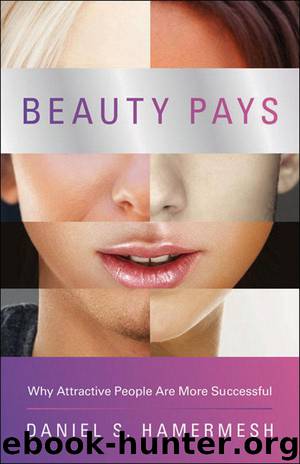Beauty Pays by Hamermesh Daniel S

Author:Hamermesh, Daniel S. [Hamermesh, Daniel S.]
Language: eng
Format: mobi
Publisher: Princeton University Press
Published: 2011-06-20T20:00:00+00:00
WHAT ARE THE SOURCES OF BEAUTY EFFECTS?
Regardless of the extent to which our preferences for beauty are socially productive or not, possibly simpler questions to answer are: (1) Whose behavior causes the beauty effects? As the discussion of the standard economic theory of discrimination made clear, preference-based discrimination could arise from the tastes of the employers themselves, from an individual’s fellow workers, or from consumers of the products or services to whose production the worker contributes. (2) Is there any direct evidence—on the amount actually produced instead of dollars of sales revenue—that beauty is even privately productive?
Combining the effects of looks on sales, profits, and pay, you would infer that discrimination by consumers is most consistent with the evidence. If employers were at fault, and consumers didn’t care about the looks of those selling to them, there could be no effect on sales. The same holds if fellow employees were the discriminators. But if consumers are discriminating, employers will profit by catering to their preferences, by hiring the beautiful and paying for the scarcity of beauty, thereby increasing sales and perhaps even profits.
The difficulty with this inference is that it is indirect—one would like something that identified the source of the discrimination more directly. If you could set up an experiment that would allow you to distinguish among these sources of the beauty premium, how would you do it? One possibility is to imagine a set of unexpected and naturally occurring disfiguring injuries that occur differentially across members of the labor force. Perhaps a plague randomly strikes adults, independent of their demographic or economic characteristics or any prior experiences that they might have had, and it renders their faces permanently and severely scarred. These disfigurements make some unfortunate workers worse-looking; and we can assume that some companies and some occupations had employed more of the disfigured workers than others. A simple test would compare wages before and not too long after the plague has struck in relation to the degree to which the workers have contact with customers. If the source of the pay difference is customer discrimination, you would expect to see a bigger drop in wages among those disfigured workers who have more customer contact.
Going still further with this same “natural experiment,” how do the before-after pay differences vary with the number of fellow employees who work with the disfigured individuals? If, for example, you find that the suddenly disfigured workers who come into contact with many other employees in their company suffer larger wage declines than those who have few fellow workers (or, indeed, if the latter experience no change in wages), you can be pretty sure that the ugly worker’s fellow employees are the source of the beauty effect in the labor market.
What if neither comparison, among workers whose jobs differ by the extent of customer contact, or among workers distinguished by the number of fellow employees, shows any difference in the before-after differences in earnings between disfigured workers and those who were more fortunate? Despite
Download
This site does not store any files on its server. We only index and link to content provided by other sites. Please contact the content providers to delete copyright contents if any and email us, we'll remove relevant links or contents immediately.
International Integration of the Brazilian Economy by Elias C. Grivoyannis(90978)
The Radium Girls by Kate Moore(11921)
Turbulence by E. J. Noyes(7936)
Nudge - Improving Decisions about Health, Wealth, and Happiness by Thaler Sunstein(7615)
The Black Swan by Nassim Nicholas Taleb(7010)
Rich Dad Poor Dad by Robert T. Kiyosaki(6401)
Pioneering Portfolio Management by David F. Swensen(6226)
Man-made Catastrophes and Risk Information Concealment by Dmitry Chernov & Didier Sornette(5921)
Zero to One by Peter Thiel(5685)
Secrecy World by Jake Bernstein(4644)
Millionaire: The Philanderer, Gambler, and Duelist Who Invented Modern Finance by Janet Gleeson(4374)
The Age of Surveillance Capitalism by Shoshana Zuboff(4209)
Skin in the Game by Nassim Nicholas Taleb(4162)
Bullshit Jobs by David Graeber(4094)
The Money Culture by Michael Lewis(4076)
Skin in the Game: Hidden Asymmetries in Daily Life by Nassim Nicholas Taleb(3929)
The Dhandho Investor by Mohnish Pabrai(3699)
The Wisdom of Finance by Mihir Desai(3653)
Blockchain Basics by Daniel Drescher(3507)
